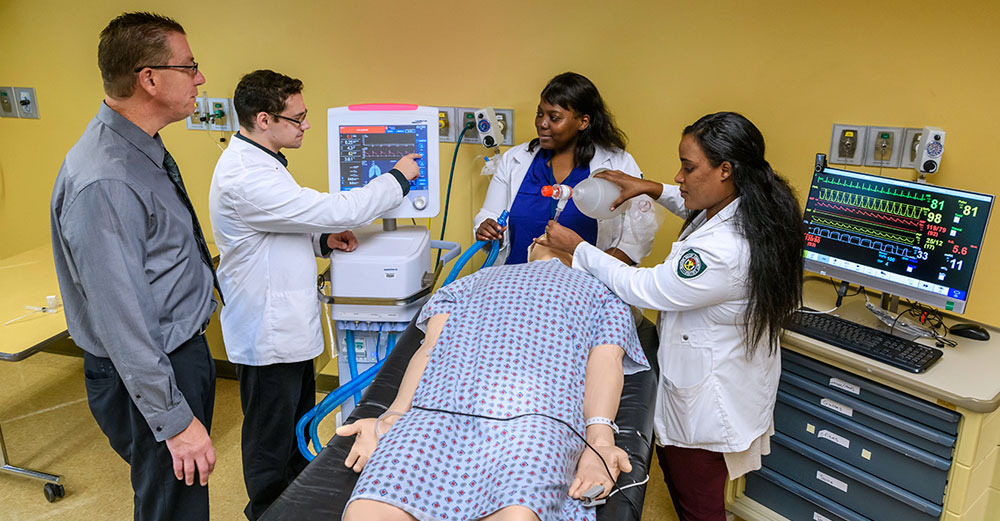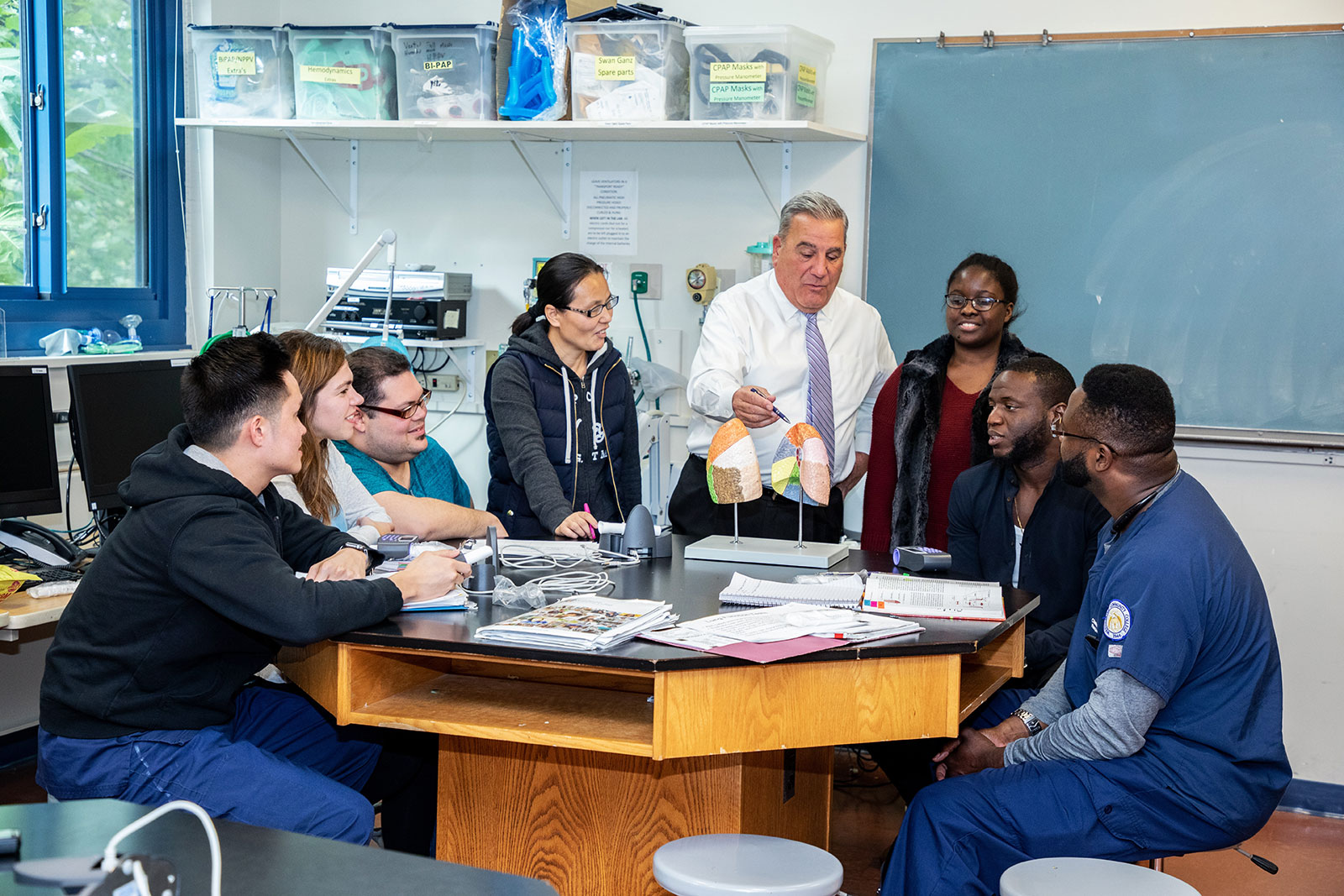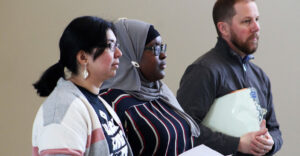
A passion for health care. A love of technology. A talent for math and science. And the courage to be with patients in their most desperate moments.
For those who possess these interests and talents, respiratory therapy provides a viable and stable career option. SUNY offers Respiratory Therapy (RT) degree programs at seven community colleges and two university centers.
In the days before the coronavirus pandemic, few people knew about respiratory therapists. In reality, RTs were always there, from alongside the incubators of neonates struggling to take their first breaths to the bedsides of the elderly taking their last. In between, they’re critical players on the medical team caring for anyone with respiratory issues, including patients with COVID-19 who sometimes experience severe acute respiratory distress.
This spring, SUNY graduated 145 students in respiratory therapy programs. SUNY has Respiratory Therapy programs at seven community colleges –Erie, Genesee, Hudson Valley, Mohawk Valley, Nassau, Sullivan and Westchester– where students get a two-year degree. SUNY also offers four-year respiratory therapy programs at two academic medical centers, Upstate Medical University in Syracuse and Stony Brook University on Long Island.
Once these newly minted graduates pass their licensing exams, they become registered RTs in New York. RTs take care of patients of all ages, who are suffering from ailments ranging from trauma to heart failure. They also work in a variety of settings, including nursing homes, sleep centers, and pulmonary rehab facilities. They are critical to the care delivered in hospitals.
“In hospitals, respiratory therapists are always part of the rapid response team and a part of the code team,” said Patricia Hyland, M.Ed., RRT, RT, who chairs the department of cardiorespiratory medicine and emergency medical services at HVCC. “They take care of patients who are very ill and in intensive care. There is a lot of technology, and interaction with patients and their families.”
Michele Pedicone, M.S., R.T., RRT-NPS, a faculty member in SUNY Upstate Medical University went back to work as an RT shortly after the outbreak began. In an interview with CBS This Morning, she said her decision was a “calling on my heart.”
“There was no way I could just sit at home and read their stories and not do something about it,” she said.
A Deep Breath
The importance of RTs was underscored by the fact that second-year students at HVCC continued their in-person clinical work, even as other healthcare students were told to do their work online.
“We were really proud of our students,” Hyland said. “Not one of them balked or were afraid.”
Erika Cardin, 23, was among the 11 who graduated early on April 28. The Albany native had mixed emotions when she first heard about COVID. “I still live at home and didn’t want to bring anything home to my family, so it was a bit nerve wracking,” she says.
Wearing PPE became essential for seeing all patients, not just those with high-risk conditions. The students were also required to do additional cleaning of the equipment. “On the first day, we were nervous,” Cardin says. “We had to bring all the proper PPE to the hospital, and adjust to the new routines being used on a day to day basis. It was definitely a new experience, but we all got used to it.”
Today, Cardin is eager to get started at her job at Albany Med. “I’m really happy I chose this field,” she says. “Every day is something different. You’re never doing the same thing. The technology we have today has allowed respiratory therapists to treat each and every patient differently and advance in our knowledge of the respiratory system itself.”
Job Security
Even before the pandemic, RTs were easily employed. In the 35 years that Patricia Hyland has worked at HVCC, all students in the program landed jobs, year after year.
This year was no exception. Half the graduating students at HVCC already had jobs lined up by January, and the other half had offers by March. All 11 will be working at Albany Medical Center or St. Peter’s Hospital.
SUNY’s RT programs provide New York hospitals and healthcare facilities with a steady supply of trained RTs. At Upstate, nine of the 14 graduates are working in central New York hospitals. At Stony Brook, six of the 23 graduates joined the staff at Stony Brook University Hospital.
Salaries are good, too. In the Capital Region, RTs start at $25-30 an hour. At the height of the pandemic, Hyland says she had emails from downstate hospitals looking for RTs willing to work for $125 an hour. “The return on investment is amazing,” she says.
But the job isn’t for everyone. The program is challenging, and doing the job requires a strong fortitude. “Though not everyone dies, you can’t be afraid of death,” Hyland says. “You have to have a thick skin, and you can’t shy away from crisis.”
Finding His Way to RT

Although some students come to respiratory therapy after high school, others like Chris Paglia, take a more circuitous route. Paglia, now 32, had been preparing for a career in communications but was never excited about the jobs he found, including a stint at a start-up company and another at a telemarketing firm.
“When I was applying for jobs, I was applying for things I wasn’t prepared to do,” says Paglia, who is from Jamesville, N.Y. “I would have to learn on the job. I wanted to be prepared before I got the job.”
Paglia was interested in healthcare, but didn’t want to be a nurse. Growing up with a sibling who had a disability, Paglia began talking to the respiratory therapist who treated his brother and one of his best friends who is a pulmonologist. Paglia was intrigued and decided to go to HVCC. He discovered he loved the field.
“I really enjoy working in ICUs, and last summer I learned eight different ventilators,” he says. “They all work the same, but there are different aspects to each one, and they’re used in different settings.”
Paglia got three job offers before deciding to accept one from Albany Med, where he will start June 22. Going into the field in the era of COVID has been both scary and exciting, but he is confident he has chosen the right field. “It took me a while to figure things out,” he says. “I’m glad where I am now.”
Patrick Barrette, MBA, RRT-ACCS, NPS, RPFT, chairman of the respiratory care department and curriculum at Westchester Community College, said the pandemic has created more awareness about respiratory therapists and what they can do to improve patient outcomes. “Many people now realize there are more than just doctors and nurses fighting this war,” he said. “RRTs have been, and will continue to be, on the front lines of this pandemic as we have always been since day one.”




So proud of all those who have chosen this career path, especially of our son, Chris Paglia. He has already helped us to understand how we can Better manage his brother’s care! You all are so appreciated! HVCC Respiratory Care program rocks!